
Vol. 7, No. 5, May 2011 |
 Printer-Friendly PDF Version Printer-Friendly PDF Version |
Advisory Board Meeting Notes
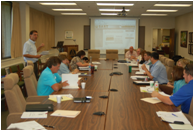
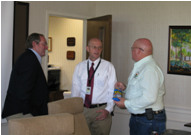
The Florida SART Advisory Board met on April 6 in the Board Room of the Florida Farm Bureau in Gainesville. Minutes of that meeting are posted on line now and can be accessed through the SART web site at http://www.flsart.org/SART/login.
Highlights of the Advisory Board meeting were:
- Review of the SART Planning Meeting
- State Hurricane Exercise
- Animal/Agricultural Training Exercise
- New Madrid Seismic Zone National Exercise
- Miami Airport Animal Import Center Exercise
- Large Animal Rescue Training/Exercise
- New SART Training Courses
- Governor’s Hurricane Conference
- Regional SART Planning Meetings
- Florida Vet Corps
[top]
More from the 2011 Planning Meeting
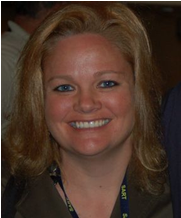 |
“AVMA VMAT is pleased to have a Memorandum of Understanding with the state of Florida and I appreciated the opportunity to represent the VMAT program at and participate in the Florida SART Planning Meeting. “As a state which has the opportunity to practice their animal emergency response plans perhaps more often than desired, Florida continues to set a very high standard in establishing and exercising animal emergency preparedness and response plans.” Heather Case, DVM, MPH, Dipl. ACVPM |
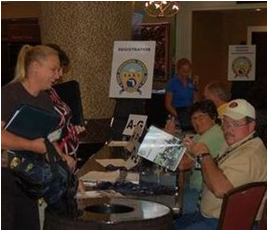 Every great meeting begins with a smooth entry through registration. |  Dr.J. Alice Agasan, Bureau Chief, Bureau of Diagnostic Laboratories speaks with FDACS' James Maxwell, DVM, Resident Director Florida Animal Disease Diagnostic Laboratories Live Oak. |
“We have lots of large animals,” says Cecilia Patella of the Hernando Sheriff’s Department, “but no financing to take care of them and we don’t quite know what to do with exotic animals in an emergency.”
 Dr. Joe Schaefer, IFAS, is South District Extension Director, Belle Glade. | 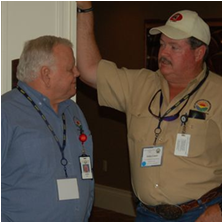 John Court (right) and Bill Jeter, both of FDACS, discuss agriculture issues. | 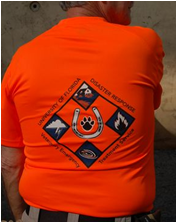 Dr. Bill Shelton, DVM, UF College of Veterinary Medicine shows off his tee-shirt. |
"Our biggest problem now is accomplishing the mission of caring for animals (and agriculture) in the face of staffing cuts and budget restraints," says Paul Studivant, St. Johns County Animal Control.
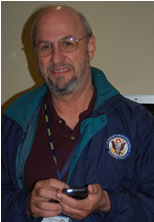 Jose Tezanos represented Monroe County Emergency Management, Marathon, FL. |  Cecilia Patella works with the Hernando Sheriff's Dept. in Brooksville. | 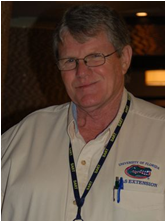
Patrick Hogue , IFAS, Livestock Agent, Okeechobee County Extension Service |
Dr. Jennifer Chatfield, DVM, notes that TRIAGE means separating and selecting. "In an emergency, triage is not only based on the condition of the patient," she says, "it also depends on available resources. Provide the greatest good for the greatest number is the rule and euthanasia is an option. It has to be."
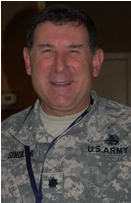 Major Robert Sindler, US Army Reserve |  Dart Members (l-r): McLane Evans (Bay Area), Sheri Evans (Sumter) and Linda Graves (Sumter). |  Pam Browning , Franklin County |
NOTE: There are plenty of additional photos from the 2011 SART Planning Meeting in Altamonte Springs posted at http://www.flsart.org/photogallery.htm.
[top]
2011 Agroterrorism Preparedness Classes
FDACS’ Office of Agricultural Emergency Preparedness collaborates with several training partners to offer DHS-certified courses in Florida. All courses are open to United States citizens and are free of charge through DHS grant funding.
Training partners include the Western Institute of Food Safety and Security at the University of California-Davis (WIFSS), the Center for Agriculture and Food Safety and Preparedness at the University of Tennessee-College of Veterinary Medicine, the University of Florida-Institute for Food and Agricultural Sciences, and the Regional Domestic Security Task Forces.
WIFSS-PRESENTED COURSES
To register for one of the AWR courses or for more information: http://wifss.ucdavis.edu/agroterrorism/classes/classesbydate.php.
AWR-151
Understanding the Dangers of Agroterrorism
A ½-day introductory course on the topic of agroterrorism, aimed at raising awareness of the need to identify and defend against pathogens, chemical and biological contaminants, and other hazards that affect food safety. The course stresses the importance of responding to incidents of intentional contamination as well as natural disasters using the “all hazards” approach. This training has been approved for 3.5 CEUs for Certified Environmental Health Professionals.
Wednesday, May 18
(By invitation only)
AWR-155
Principles of Frontline Response to Agroterrorism
and Food Systems’ Disasters
A 1-day course focusing on how an effective frontline emergency response can reduce or mitigate the effects of an agricultural emergency, an act of agroterrorism or other food system disaster. Frontline agricultural and public safety response teams, including personnel from the county, regional, state and federal agencies, receive a comprehensive program formed around the principles of the Incident Command System (ICS) and the concept of Unified Command. This training has been approved for 5.0 CEUs for Certified Environmental Health Professionals.
Wednesday, May 11
Ft. Myers
Lee County Port Authority Training Facility, 15924 Air Cargo Lane
Thursday, May 12
Sarasota
Sarasota County Govt. Administration Center EOC, 6th Floor 1660 Ringling Blvd.
AWR-156
Principles of Planning and Implementing Recovery
A 1-day course focusing on the fundamental framework for orchestrating the recovery from an incident of agroterrorism. The course covers critical factors for success in a community recovery effort: identification of the components of a recovery plan targeted at minimizing the economic impact to the community and its citizens, and the identification of community resources and assets available for building partnerships. This training has been approved for 6.0 CEUs for Certified Environmental Health Professionals.
Wednesday, June 8
Seffner
Hillsborough County Extension Office, 5339 S County Road 579
Thursday, June 9
Sanford
Seminole County EOC, Dept. of Public Safety, 150 Bush Blvd.,
UNIVERSITY OF TENNESSEE-PRESENTED COURSES
To register for one of the MGT courses or for more information: http://flsart.org/mgtcourses/.
MGT 337
Agriculture & Food Vulnerability Assessment
(Utilizing the Carver + Shock method)
A 1 ½ day course (Day 1 from 8:00 a.m. to 5:00 p.m. with one hour for lunch and Day 2 from 8:00 a.m. to 1:00 p.m.) to assist food regulation, law enforcement, and industry personnel in the prevention and deterrence of criminal acts that target the food industry. Registration through John Burkette, FDACS Office of Agricultural Emergency Preparedness: (850) 245-1387 John.Burkette@freshfromflorida.com or go to http://flsart.org/mgtcourses/ for information and links to online registration.
Miami: At the FDLE facility, 1030 NW 111th Ave.
Tuesday-Wednesday, May 10-11
Sanford: Seminole County Sheriff’s Office, 150 Bush Blvd.
MGT 259
Sharing Information and Intelligence
Related to Food Importation and Transportation
A 1-day course (8:00 a.m. to 5:00 p.m. with one hour for lunch) to prepare participants to utilize and implement effective sharing of information and intelligence to enhance food safety and security related to food importation and transportation. This course is targeted for law enforcement, state Fusion Center personnel, emergency managers and responders, extension, public health, food and agriculture professionals, the transportation industry and federal, state, local, tribal and regional officials. Registration through John Burkette, FDACS Office of Agricultural Emergency Preparedness: (850) 245-1387 John.Burkette@freshfromflorida.com or go to http://flsart.org/mgtcourses/ for information and links to online registration.
Thursday, May 26
Winter Haven
Polk State College, 999 Ave. H NE, Student Center WST 126.
Tuesday, June 28
Jacksonville
At the FDLE facility, 921 N Davis Street, Bldg. E.
Remember when? Quotes from 2008 AVMA Disaster Medicine Symposium 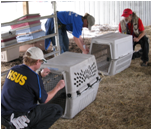 | “The problems and plans we are working with are not just animal issues. They’re people issues, too. Animal issues compound human emergencies.” “To have an effective response, you have to work within the system. To go out on your own, freelancing, doesn’t work.”
|
[top]
UF College of Veterinary Medicine Training – May 1
“This was a multi-agency training and workshop weekend similar to what the UF College of Veterinary Medicine has helped organize over the past few years,” says John Haven, Director of the College. “This year we focused on horses. In the recent past, as a result of the Pets Act*, SART has spent a lot of time and energy focused on companion animal issues; however it recognized a need to get back to its agricultural roots and support developing its all-animal response needs.”
Haven says Sunday morning May 1 was a skills lab, taught by the outstanding IFAS Horse Teaching Unit (HTU) staff, led by Joel McQuagge. Staff instructed in basic horse handling skills and techniques. The afternoon taught horse sheltering and involved “going out and capturing horses” that needed rescue in their paddocks followed by triage, decontamination, shelter intake, medical evaluation and sheltering.
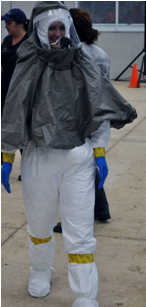 | 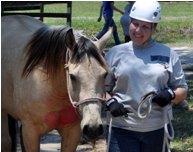 Dr. Kendra Stauffer (in PPG-left, and introducing self to horses-right) USDA Area Emergency Coordinator for Florida. Above, McLane Evans, Bay Area DART, leads a horse to decon. | 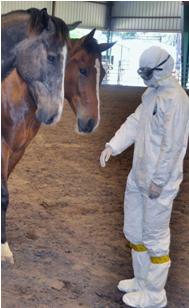 |
The event involved more than 70 participants from many agencies – including FDACS, USDA, Vet Med VETS team (faculty, staff and students), Vet Corps reserve members, various DART teams, SARC, ASPCA, and etc. “For two-thirds of participants, this was their first time really working with horses, so this was a great first step in helping the NGO partners expand capabilities beyond companion animals,” Haven noted. “HTU instructors provided extremely gentle horses and that helped make the event safe and successful, and the UF’s HTU is an incredible facility to train in. Dr Kendra Stauffer from USDA provided PPE for the decontamination portion and demonstrated the wearing of the equipment.”
 | 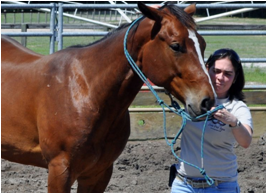 |
At left, Dr. Cynda Crawford of UF's College of Veterinary Medicine discusses the medical plan with CVM faculty, students and Vet Corps team members. At right, Blancy Torres , halters a horse. | |
The principal teaching events took place on May 1, but many people arrived the night before and camped on site. Haven says camping has been part of the deployment practice tradition for Florida training events, and it is a great time to build relationships between responders.
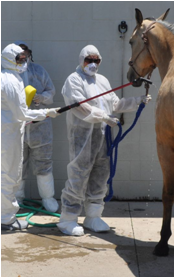 | 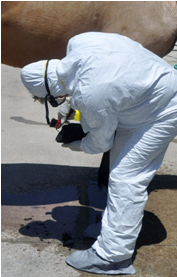 | 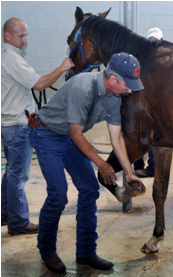 |
Steps in the large animal decontamination process. "We have a deficit in horse skills," says John Haven, Director of the CVM, "and this could be a problem for SART. This class at UF's Horse Teaching Unit led by Joel McQuaggie is a great step toward fixing that situation." | ||
- In the fall of 2006, Congress passed H.R. 3858, the Pets Evacuation and Transportation Standards Act of 2006 (PETS Act). On Friday, October 6, 2006, President George W. Bush signed the PETS Act into law.
- Photos courtesy John Haven
[top]
National Animal Health Emergency Response Corps
Membership Exceeds 1,400
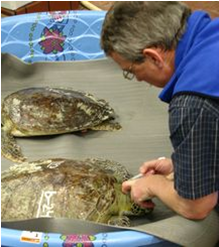
Veterinary professors assisted by students monitor the health of sea turtles at the University of Florida College of Veterinary Medicine during the massive 2010 Gulf of Mexico oil spill. (Rick Sapp photo)
The recent massive foot-and-mouth disease outbreak in South Korea highlights the need for trained responders. APHIS’ National Animal Health Emergency Response Corps (NAHERC) has more than 1,400 volunteers – 618 veterinarians and 853 animal health technicians – who can help meet critical staffing needs in the event of a serious foreign animal disease (FAD) outbreak or natural disaster.
APHIS established NAHERC in 2001 to respond to FAD outbreaks and other disasters that affect livestock, poultry, companion animals and wildlife. Volunteers are spread throughout the nation (see map) and can be quickly mobilized to assist with activities such as disease sampling and surveillance, program support, animal care and mass evacuation. In addition to veterinarians and animal health technicians, college students are also eligible. NAHERC volunteers become temporary federal employees who are paid for their service. Tours of duty generally last 21 to 30 days.
To learn more about NAHERC and how to apply, please visit http://www.aphis.usda.gov/animal_health/emergency_management/naherc.shtml or contact NAHERC’s Coordinator Tom Cunningham at (301) 734-4933 or by email at thomas.m.cunningham@aphis.usda.gov.
[top]
Florida's Nuclear Signature
Following the disaster in Japan where an earthquake followed by a tsunami wrecked three reactor units at the Fukushima Daiichi nuclear power plant, many people have been wondering if something similar could happen in Florida. At present the Sunshine State has three operating nuclear power plants:

Crystal River (Emergency Management is located in the Sheriff’s Office in Lecanto, Citrus County and online at http://www.sheriffcitrus.org/EM/EOC.html)
The $1.5 billion Crystal River Energy Complex began operation in March 1977. The plant produces 860 megawatts of electricity, covers 4,700 acres and is cooled by water from the Gulf of Mexico. It is located 35 miles southwest of Ocala, in Citrus County.
In December, 2008 North Carolina’s Progress Energy applied to the Nuclear Regulatory Commission for a 20-year operating license extension. The current license expires in 2016.
Having a nuclear plant in our community makes our planning more difficult because we may be dealing with anything from sheltering pets during a major event in which there is mandatory evacuation to decontaminating household pets in an effort to save their lives.
There is also the potential that our food source animals could be affected. Citrus County is the home of M&B Dairies, a huge milking and packaging operation. If these animals were affected there would be huge concerns, for example, on how to dispose of that number of carcasses.
Pattie Amon, Operations Manager
Community & Recreational Programs / Animal Services
Inverness, FL

St. Lucie (Emergency Management is located in the Public Safety & Communications Office in Ft. Pierce, St. Lucie County and online at http://co.st-lucie.fl.us/eoc/)
Owned by Florida Power & Light the $4.6 billion St. Lucie power plant is located on a 1,130-acre site on narrow Hutchinson Island, across the Indian River from the mainland and about eight miles southeast of Ft. Pierce. It employs about 800 people, produces 1,678 megawatts of electricity and is cooled by water drawn from the Atlantic Ocean.
St. Lucie was approved for a 20-year license extension in October 2003. The license for Unit 1 expires in 2036 and Unit 2 expires in 2043. FP&L has produced a booklet “Safety planning information for neighbors of FPL’s St. Lucie Nuclear Power Plant” http://co.st-lucie.fl.us/pdfs/FPL_Planning_Book.pdf. The booklet says an emergency at this plant is “unlikely.”

Turkey Point (The Department of Emergency Management of Miami Dade County is online at http://www.miamidade.gov/oem/.)
Although the $1.0 billion Turkey Point facility has four electric generation units, only Units 3 and 4 are nuclear powered; Units 1 and 2 are fossil-fired. This complex employs about 800 people and is owned and operated by Florida Power & Light. It is located on a 3,300-acre site near Miami. The nuclear units produce 1,386 megawatts of electricity and are cooled by water from the Atlantic Ocean.
Turkey Point was approved for a 20-year license extension in June 2002. The license for Unit 3 expires in 2032. The license for Unit 4 expires in 2033.
CEMP Page 26 – Nuclear Power PlantThe Turkey Point Nuclear power plant is located in the southeastern portion of Miami-Dade County adjacent to Biscayne Bay and approximately 10 miles south of Cutler Ridge. Nine of the ten areas within the ten-mile Emergency Planning Zone (EPZ) are inside Miami-Dade County. All of Miami-Dade County is within the 50-mile Emergency Planning Zone. The Florida Division of Emergency Management (DEM) has the overall responsibility for the coordination of any response to a nuclear power plant emergency by federal, state or local agencies. Miami-Dade County's immediate responses for protecting its residents in the event of a nuclear power plant emergency are contained in the Turkey Point Procedure which can be found in Volume III of the CEMP. (rev. June 2008)
Florida’s nuclear capacity is only seven percent of the state’s total electric generating capacity, placing nuclear fourth behind natural gas, petroleum and coal. Florida imports 11 percent of its electric power use.
Nuclear Updates
1. A new crack in Progress Energy’s Crystal River nuclear plant’s containment building has forced the utility company to again scrap plans to fire up the facility.
2. On July 30, 2008, Progress Energy applied to build two reactors at a Levy County site about 10 miles northeast of the Crystal River nuclear plant. There are no reactors currently located here. If construction is approved, the work would begin in 2016 or later.
3. On June 30, 2009, Florida Power & Light applied to build two additional reactors at Turkey Point.
[top]
Alabama – Disaster and Readiness
Because Alabama was hammered so hard by the storm system that passed through the state in late April, you may have paid attention to the disasters affecting its agriculture and animals. Indeed, poultry-raising was hit very hard.
Alabama Dept. of Agriculture & Industries: Damage Report
Preliminary Totals*
Poultry Houses
Damaged = 514+
Destroyed = + 207
Bird Deaths = 2,858,800+
Livestock Deaths = 38 cows and 19 horses
* Report dated the afternoon of May 2nd. Numbers continue to rise.
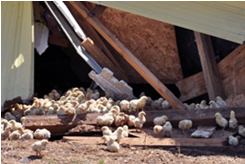 The storms devastated Alabama's $2.4 billion poultry industry, leveling chicken houses, killing birds and knocking out power to feed mills and processing plants.
The storms devastated Alabama's $2.4 billion poultry industry, leveling chicken houses, killing birds and knocking out power to feed mills and processing plants.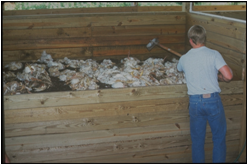 Composting poultry.
Photo courtesy USDA-NRCS.
Composting poultry.
Photo courtesy USDA-NRCS.Alabama has a SART program (see http://alsart.org/default.aspx?sm=a_a) with a slightly different emphasis than that of Florida and yet the traditional SART focus on planning, communicating and training stands out:
“The Alabama State Agricultural Response Team (SART) is an interagency, coordinated effort dedicated to effectively communicating and planning for agriculturally-related emergencies and disasters that will occur within the State of Alabama. The team’s mission is to develop and implement procedures and train participants to facilitate a safe, environmentally sound and efficient response to agricultural emergencies on the county, regional, and state levels.”
Brad Fields, DVM/MPH (currently deployed to Afghanistan as Officer in Command, 358th Medical Detachment, Veterinary Services), a Veterinary Medical Officer with the Dept. of Agriculture & Industries, is Director of Emergency Programs and head of the Alabama State Agricultural Response Team. As such, he and acting head Ben Mullins are tasked with:
- development and implementation of agriculture emergency planning and response, emergency program guidance and oversight,
- oversight of the Homeland Security Grant Program, as well as funding streams from other agencies, and serves as
- the primary liaison between private and public agencies and the AL Dept of Agriculture for disaster response and recovery.
An example of training opportunities in Alabama was a Foreign Animal Disease Full Scale Exercise on June 17, 2008. Many federal, state and local agencies, as well as stakeholder groups worked for more than three months to design the exercise which was a follow-up to a Foreign Animal Disease Tabletop Exercise in October, 2007. The purpose was to give participants an opportunity to evaluate “current response concepts, plans, and capabilities” in response to a foreign animal disease outbreak. The exercise focused on local emergency responder command and control, critical decisions, notifications and integration of state and federal assets necessary to save personal property, private industry, the economy and to protect public health and security. (Photos of this and other Alabama SART exercises and interests are available online at http://216.226.177.101/photo_gallery.aspx)
[top]
News & Notes
Laura Bevan – Aid to Alabama

Laura Bevan at a SART Advisory Board meeting.
May 4, Tuscaloosa, AL: On Wednesday April 27, a storm front that included 28 tornadoes – at least one of them a mile wide with devastating and sustained F4-class wind* in excess of 200 mph – killed at least 236 people in Alabama and caused hundreds of millions of dollars in damage. Disaster response teams from around the U.S. were called to help, several of them from Florida.
Florida SART’s Laura Bevan is assisting on the ground along with experienced volunteers from Sumter DART, Bay Area DART, several trained individuals from Miami-Dade Animal Control and others.
“We were in Birmingham at first,” Bevan said, “but they have lots of resources and people there. We shifted to the Tuscaloosa area and it’s like night and day.
“Tuscaloosa only has a small shelter and two animal control officers. The huge tornado that came through downtown and some residential areas – heavily populated areas – just cut like a knife. The place is demolished.”
The Florida responders bring significant training and disaster experience, plus a sense of mission-related organization to animal relief efforts. “Our experiences primarily with hurricanes are a little different,” says Bevan, surveying the damage, shouting to volunteers and talking on her cell phone. “A hurricane leaves a wide swath of destruction that varies in intensity. But this – what I see here – is extreme.”
Is the ICS system for command and control being used? Well, apparently not….
“We are using the ICS system internally,” Bevan says, “but the folks here are still stunned and this is ‘their disaster.’ They’re still looking around and wondering what happened to their community, but they’re thrilled to have us here. I think it has all been pretty overwhelming for them. They don’t really have a hierarchy and they’re not using the ICS system for structure like we would use in Florida. They don’t seem to have a defined emergency management system either so we just try to figure out who is in charge when we go somewhere.”
(Laura Bevan promised a more extensive report and photos of Florida volunteers for a SART follow-up.) * Only one percent of all tornadoes in the world are classified in the F4 or higher category.
Hillsborough County’s Bill Armstrong Retires

Hillsborough County's Bill Armstrong
Bill Armstrong, a strong leader in emergency response and supporter of SART is retiring on June 30th. “Retirement will give me the time and opportunity to seek other challenges, and most importantly, to spend quality time with my wife, my children, and our granddaughter,” Bill wrote in a recent retirement letter.
“His accomplishments have been many and he demonstrates the character of a true leader and public servant.”
Michael S. Merrill
Hillsborough County Administrator
“During my nearly 15 years working for Hillsborough County I have had the privilege of working with many fine professionals who are truly committed to making our community a better place. I will miss the people I worked with in Code Enforcement and the Affordable Housing Office when I was their Interim Director. But most of all, I will miss the great, professional people I have had the honor and privilege to work with at Animal Services. It is these men and women who have made a huge difference in making our community a better place for both people and pets despite the many challenges they have faced on a nearly constant basis.
“I hope to see you sometime in the future as I intend to stay active in the Humane Community and will assist where I can. The experience my staff and I have gained in working with you during disasters (the aftermath of Katrina and Florida’s 2004 hurricanes) and/or exercises has equipped us to better deal with a major disaster in our own community. This in turn will help us to better protect the public's safety and help insure the humane care of pets, and for that, I will be ever grateful.”
Bill can be contacted at armstrong610@verizon.net.
SFWMD Declares Water Shortage – Agriculture Hit Hard
With regional water levels falling and no significant rainfall forecast, South Florida Water Management District (SFWMD) Executive Director Carol Ann Wehle signed orders on March 22 declaring an official water shortage in South Florida.
Lake Okeechobee, the backup water supply for South Florida, has dropped to 11.76 feet, more than two feet below average for this time of year and levels are expected to continue to fall due to rising temperatures and evaporation rates. Also, the region has received less than half of its average rainfall, following the driest October-to-February period in 80 years.

District water shortage orders include:
- residential and business irrigation restraints that affect the district’s 7.7 million residents. (Landscape irrigation accounts for half of all potable (drinking) water use in South Florida.)
- a 15-percent cutback for all agricultural, nursery and diversion and impoundment surface water users within the Lake Okeechobee Service Area. (Cisterns and low-volume irrigation systems – such as drip, bubble and micro-jet systems that apply water directly to plant root zones – may be used at any time, although voluntary reductions are encouraged. Irrigation with reclaimed water is exempt.)
- a 15-percent cutback for golf course irrigation.
- a limit on hours permissible for irrigation.
Links to information about irrigation limits by area, current conditions and water-savings tips are available at www.sfwmd.gov/waterwatch.
The Florida Good Samaritan Law
Can you be sued when you respond to an emergency?
Are you protected? Does the law apply to you?
Florida Statute 768.13 Good Samaritan Act; immunity from civil liability.
(2)(a) Any person, including those licensed to practice medicine, who gratuitously and in Good faith renders emergency care or treatment either in direct response to emergency situations related to and arising out of a public health emergency declared pursuant to s. 381.00315, a state of emergency which has been declared pursuant to s. 252.36 or at the scene of an emergency outside of a hospital, doctor's office, or other place having proper medical equipment, without objection of the injured victim or victims thereof, shall not be held liable for any civil damages as a result of such care or treatment or as a result of any act or failure to act in providing or arranging further medical treatment where the person acts as an ordinary reasonably prudent person would have acted under the same or similar circumstances.
(b)1. Any health care provider, including a hospital licensed under chapter 395, providing emergency services pursuant to obligations imposed by 42 U.S.C. s. 1395dd, s. 395.1041, s. 395.401, or s. 401.45 shall not be held liable for any civil damages as a result of such medical care or treatment unless such damages result from providing, or failing to provide, medical care or treatment under circumstances demonstrating a reckless disregard for the consequences so as to affect the life or health of another.
A Little SART History
The Florida SART concept was first conceptualized in June, 2003 during discussions between UF’s IFAS (Dr. Joan Dusky and Dr. Larry Arrington), the USDA’s FSA (Mr. Tim Manning) and FDACS’ DAI (Dr. Greg Christy). November 13, 2004 marked the first meeting and formal evaluation of the North Carolina model to judge its applicability to the state of Florida. The immediate SART goals were:
- Form a working group for the development of a web site.
- Form a working group to develop manuals and training modules.
- Form a working group to plan the first annual training session.
- Contact two counties to act as models to represent the county perspective.
Committees were subsequently formed to focus on initial curriculum development and training. The training events scheduled for fall of 2004 were cancelled due to Tropical Storm Bonnie and Hurricanes Charley, Frances, Ivan and Jeanne. Training was rescheduled for the spring of 2005.
Future challenges foreseen at the time were: adding food safety and processing issues to oversight and emphasizing bio-security issues.
[top]
About the SART Sentinel |
The SART Sentinel is an e-mail newsletter prepared monthly by the members of the Florida State Agricultural Response Team. Past issues of the Sentinel are archived on the Florida SART Web Site www.flsart.org. If you have a story or photo that you would like to have considered for publication in the SART Sentinel, please contact the editors. Editor: Rick Sapp, PhD, Technical Writer, Florida Department of Agriculture & Consumer Services, Division of Animal Industry rsa5@cox.net Associate Editor: Joe Kight, State ESF-17 Coordinator, Florida Department of Agriculture & Consumer Services, Division of Animal Industry Joe.Kight@freshfromflorida.com [top] |
